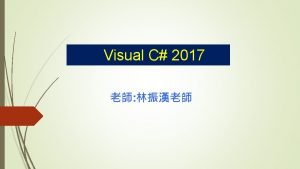Simple Example Open Microsoft Visual Studio 2005 Chinese





![Simple Example • Use [Web. Method] to add new function Add(int x, int y) Simple Example • Use [Web. Method] to add new function Add(int x, int y)](https://slidetodoc.com/presentation_image_h2/5c009b8ca3b732ade56231d945ee9d2f/image-6.jpg)




- Slides: 10

Simple Example • Open Microsoft Visual Studio 2005: © Chinese University, CSE Dept. Distributed Systems / 9 - 1

Simple Example • Click “File New Website” • Select the “ASP. NET Web Service” and select C# as the language. • Click “OK”. © Chinese University, CSE Dept. Distributed Systems / 9 - 2

Simple Example • In the windows of Visual Studio, press “Ctrl + F 5” to run the default Web service: © Chinese University, CSE Dept. Distributed Systems / 9 - 3

Simple Example • Click “Hello. World” to invoke this function. Click “Invoke” in the shown page, you will get the invocation result: • • By these simple steps, you create a Web service, which contains a simple function named “Hello. World” The address of your Web service is: http: //localhost: 1336/Web. Site 1/Service. asmx The WSDL (Web Service Description Language) file of your Web service is available in: http: //localhost: 1336/Web. Site 1/Service. asmx? wsdl Please note that the port number (1336 in the above example) and Website name (Web. Site 1 in the above example) may be different in your computer. © Chinese University, CSE Dept. Distributed Systems / 9 - 4

Simple Example • The WSDL document of the Web service provides descriptions of the Web service functionalities (e. g. , function name, input, output, ect. ). By parsing this WSDL file, other programs can invoke this Web service easily. © Chinese University, CSE Dept. Distributed Systems / 9 - 5
![Simple Example Use Web Method to add new function Addint x int y Simple Example • Use [Web. Method] to add new function Add(int x, int y)](https://slidetodoc.com/presentation_image_h2/5c009b8ca3b732ade56231d945ee9d2f/image-6.jpg)
Simple Example • Use [Web. Method] to add new function Add(int x, int y) • Place Public before the function procedure © Chinese University, CSE Dept. Distributed Systems / 9 - 6

Simple Example • Press “Ctrl + F 5” to run the Web service which includes two functions, i. e. , Hello. World and Add. • Click “Add” to invoke the Add function. Type some values into the form and click “Invoke”. © Chinese University, CSE Dept. Distributed Systems / 9 - 7

Simple Example • There a lot of publicly available Web services in the Internet, which provide useful functionalities. We can make use of these Web services by writing codes to invoke them. • Right click “Website 1” and select “Add Web Reference…” • Type in the Web service address: http: //www. webxml. com. cn/Web. Services/Ip. Address. Search. Web. Service. asmx? wsdl • Click “Go” and click “Add Reference” to add the Web service into the project. © Chinese University, CSE Dept. Distributed Systems / 9 - 8

Simple Example • Add the following codes to the file “Service. cs”. • The above codes invoke an Internet Web service named Ip. Address. Search. Web. Service to get the geographic information from an IP address. • Press “Ctrl + F 5” to run the Web service, which includes three functions: © Chinese University, CSE Dept. Distributed Systems / 9 - 9

Simple Example • Click “IPAddress”. Type in an IP address and click “Invoke” to get the results: • Now, your Web service can provides the geographic location service to the user. • By these simple codes, you have created a Web service, which provides three functions (Helloworld, Add, and IPAddress) to the users. When the third function (i. e. , IPAddress) receives a user request, it invokes another Internet Web service to get the results and return the results to the user. © Chinese University, CSE Dept. Distributed Systems / 9 - 10
 Microsoft visual studio 2005 tools for applications
Microsoft visual studio 2005 tools for applications Visual studio 2010 tutorial
Visual studio 2010 tutorial Visual studio 2005 team suite
Visual studio 2005 team suite Visual studio 2005 professional
Visual studio 2005 professional Visual studio 2005
Visual studio 2005 Msdn operating systems subscription
Msdn operating systems subscription Visual studio 2005
Visual studio 2005 Visual studio 2005 team
Visual studio 2005 team Sql server 2005 express management studio
Sql server 2005 express management studio Xna game studio visual studio 2017
Xna game studio visual studio 2017 Xna game studio visual studio 2017
Xna game studio visual studio 2017
















